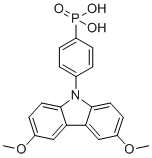Online Database of Chemicals from Around the World
| Xi'an Yuri Solar Co., Ltd. | China | Inquire | ||
|---|---|---|---|---|
 |
+86 (029) 8110-1199 | |||
 |
jiaop@yurisolar.com | |||
 |
QQ chat | |||
 |
WeChat: plt18092602675 | |||
| Chemical manufacturer since 2007 | ||||
| chemBlink standard supplier since 2025 | ||||
| Classification | Chemical reagent >> Organic reagent >> Phosphonate / phosphonate |
|---|---|
| Name | MeO-PhPACz |
| Synonyms | (4-(3,6-Dimethoxy-9H-carbazol-9-yl)phenyl)phosphonic acid |
| Molecular Structure |  |
| Molecular Formula | C20H18NO5P |
| Molecular Weight | 383.33 |
| CAS Registry Number | 3046309-17-2 |
| SMILES | C1=C(C=C3C(=C1)[N](C2=CC=C(C=C2)[P](=O)(O)O)C4=CC=C(C=C34)OC)OC |
| Density | 1.39±0.1 g/cm3, (20 ºC, 760 Torr)Calc.* |
|---|---|
| Boiling Point | 566.8±60.0 ºC, Calc.* |
|
MeO-PhPACz (methoxy-phenyl-substituted acridino\[2,1,9-def]carbazole) is a specially designed hole-transporting material (HTM) developed for use in organic electronics and perovskite solar cells. It belongs to a family of acridino–carbazole-based compounds that are engineered to provide high thermal stability, excellent film-forming ability, and suitable energy levels for charge transport. The structural framework of MeO-PhPACz combines an acridine moiety fused to a carbazole, further functionalized with a methoxy-substituted phenyl group. This combination of rigid aromatic cores and electron-donating substituents provides an optimal balance of electronic and morphological properties for device applications. The discovery of MeO-PhPACz arises from the broader development of molecular hole-transport materials as replacements for classical HTMs such as spiro-OMeTAD. While spiro-OMeTAD has been widely used, it suffers from stability issues and often requires dopants to achieve high conductivity, which complicates processing and long-term device performance. Researchers began exploring acridino–carbazole derivatives because the fused heteroaromatic backbone provides enhanced planarity, strong intermolecular interactions, and stability under operational conditions. By introducing methoxyphenyl groups, the solubility and film morphology of the compound were improved, while also fine-tuning its highest occupied molecular orbital (HOMO) energy level to match the requirements of perovskite absorbers. Applications of MeO-PhPACz are primarily found in the fabrication of high-efficiency perovskite solar cells. The material serves as a dopant-free hole-transport layer (HTL) that facilitates the extraction and transport of photogenerated holes from the perovskite absorber to the electrode. Unlike doped HTMs, which can be prone to ion migration and instability, MeO-PhPACz functions effectively without additional dopants, thereby improving device stability. In optimized perovskite solar cells, the use of MeO-PhPACz has been reported to yield power conversion efficiencies above 20%, with significantly improved operational stability compared to conventional spiro-OMeTAD-based devices. Beyond photovoltaics, MeO-PhPACz and related compounds are of interest in organic light-emitting diodes (OLEDs) and other optoelectronic devices where stable, high-mobility hole-transport materials are essential. The strong thermal and morphological stability of this molecule allows for uniform thin-film deposition, an important feature for large-area device manufacturing. Moreover, the combination of electron-donating methoxy groups and extended aromatic conjugation provides favorable charge-transport dynamics, which contributes to both performance and reliability. In addition to device-level applications, MeO-PhPACz demonstrates the design principles guiding the next generation of molecular semiconductors. Its success illustrates how carefully tailored molecular architectures—incorporating fused aromatic systems, functional substituents for solubility, and energy-level alignment—can overcome the limitations of traditional HTMs. The compound has thus influenced ongoing research into dopant-free, stable, and high-performing organic semiconductors for renewable energy and display technologies. In conclusion, MeO-PhPACz is a representative example of advanced acridino–carbazole derivatives used in optoelectronics. Discovered through the pursuit of more stable and efficient HTMs, it is mainly applied in perovskite solar cells, where it contributes to both high efficiency and operational longevity. Its design and applications underscore the importance of molecular engineering in the development of next-generation organic semiconductors. |
| Market Analysis Reports |
| List of Reports Available for MeO-PhPACz |